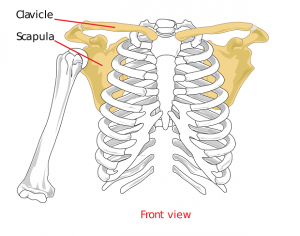 Written by Virginia Eaton —
Written by Virginia Eaton —
How are your shoulders feeling?
Can you still reach overhead to get something out of the cupboard? Do you have difficulty putting on a sweater or a jacket?
As I work with older adults, I hear shoulder complaints more often than any other, so I was thrilled when I started reading some interesting research about how to maintain shoulder health as we move through the years.
Over the last year, I’ve been using this exercise with a variety of clients with good success.
Before jumping into the exercise, you need to understand how complex the shoulder is. While it is technically considered a ball and socket joint (the hip is another ball and socket joint) the “socket” part is so shallow that if the muscles surrounding the joint aren’t working well, you have a problem.
The shoulder is one of the most intricate joints in the body, comprised of the upper arm bone (humorous), the collar-bone (clavicle) and shoulder blade (scapula). Four muscles that make up the rotator cuff ( supraspinatus, infraspinatus, teres minor and the subscapularis) hold these bones together.
 These four muscles are vital for to keeping the shoulder moving in all the ways that we expect—rotating and raising the arms. When those muscles and tendons (a tendon is fibrous tissue that connects a muscle to a bone) become inflamed from either over use or under use, it hurts to reach over head or rotate your arm as you would when putting on a jacket or reaching behind you.
These four muscles are vital for to keeping the shoulder moving in all the ways that we expect—rotating and raising the arms. When those muscles and tendons (a tendon is fibrous tissue that connects a muscle to a bone) become inflamed from either over use or under use, it hurts to reach over head or rotate your arm as you would when putting on a jacket or reaching behind you.
In general, you want to move your body in all the ways that it was meant to move everyday in order to keep the joints moving smoothly, the muscles and tendons toned and lubricated. When it comes to the shoulder, rolling your shoulders forward and backwards, squeezing your shoulder blades together and reaching overhead with one arm and then the other are good ways to keep shoulders moving. I recommend these moves to most of my clients and last year have added a new move.
The ‘interesting research’ that I came across provides traction to the shoulder joint, and I have been using this in my classes and with private clients with good results.
Hanging can loosen up tight shoulders and start to prepare them for a strengthening routine. If you have or had a shoulder injury or if you have not been exercising regularly, check in with your doctor or physical therapist before adding anything new to your routine. The idea is to use a pull-up bar or a sturdy tree branch and, using both hands, reach up and grab hold. You should feel a comfortable stretch in the shoulders, armpits and upper back.
Begin with just bending your knees enough to feel a little more pull in the arms and see how that feels. You can move around in this position — try hanging with one arm and then the other, or change up your hand position to see how that feels.
 Be playful with this exercise — think about when you were a child and played on the bars at the playground. Keep in mind the intensity level you should feel. On a scale of 1-10 where 1 is virtually no intensity and 10 is painful, you should keep the intensity around 3. It should feel good, not painful or so intense that you can’t breathe comfortably.
Be playful with this exercise — think about when you were a child and played on the bars at the playground. Keep in mind the intensity level you should feel. On a scale of 1-10 where 1 is virtually no intensity and 10 is painful, you should keep the intensity around 3. It should feel good, not painful or so intense that you can’t breathe comfortably.
This video shows how to gently move into a hanging session for shoulder health.
The results that my clients have shared with me after using this exercise for a couple of weeks is looser, less stiff shoulders, decreased neck pain and tension and less lower back discomfort. If you decide to try this, let me know what you think.
Read more of Virginia Eaton’s blog posts here.
Virginia Eaton is the owner of Oakhurst wellness center Class: The Body Pastiche




